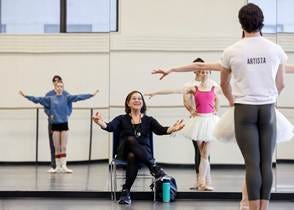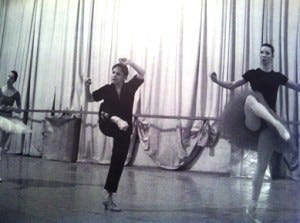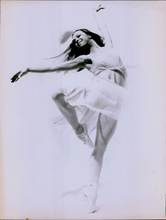Interviews with Artists who Make the Difference: Marina Eglevsky
Cooking dance magic on world stages: a miracle to behold!
If, during one lifetime, one has been fortunate to work with wonderful artists, Marina Eglevsky is one of the most impressive beings I ever met. Born with a family legacy the size of an Olympic match for heavy weights, her parents gifted her with their great tradition from Diaghilev Ballets Russes’s legendary Michael Fokine, maestro Enrico Cecchetti and George Balanchine, a newborn who seemingly had no other choice but to follow. While Balanchine created his legendary works on her mum and dad, she sat under the piano watching them. As a 15-year young professional dancer, choosing the newly founded Harkness Ballet and not the New York City Ballet was a strong statement to fly her to new horizons, on European trips, joining Hamburg Ballet and later the Royal Winnipeg Ballet. It was also a prelude to her own outstanding, meticulous teaching & staging Mr. B’s ballets, inherited through her father, she stages worldwide (ABT, NYCB, Bolshoi, Paris Opera, etc.) A ballet mistress par excellence uniquely transmitting such wealth, her life’s adventure drew her into her own healing to becoming one of the best therapists the ballet world can dream off. Marina continues to care for all the dancers (and non-dancers) she so generously helps wherever she graces the companies and schools. (Marina teaching “Sylvia” at NYCB, with Tyler Peck & co; photo courtesy NYCB, 2025)
WalkYourTalk: I first remember you from the Hamburg Ballet when you were one of John Neumeier’s muses. But you were on stage very really early in your life, what are your first memories of being on a public stage?
Marina: My childhood was not easy. It seemed glamorous to outsiders. But as a 3-year-old, already putting on point-shoes and appearing with my father was quite unusual and challenging. So, I had to be good, I had to be perfect. It was not a silent request but a demand of me. Father was an imposing figurehead, and he was also my teacher. In my parents’ school we had the Russian training they had received from the school of Cecchetti, Nicolas Legat, Matilda Kschessinska. My mother was a protégé of Michael Fokine and later a founding member of NYCB. Aside from father and mother looming over me as huge dance personalities, I grew up close to Balanchine, their friend. They’d sit and chat in this room right next to the first NYCB studios on Broadway. I’d be a silent observer; watching and listening. In Mr. B’s class, at the age of three, I sat in on rehearsals daily and I was cast, age 6, for many years to come, in his legendary Nutcracker from a rabbit to little Marie! Mr. B was everywhere, and of course another major note in my youthful symphony. Even at my parents’ school, we did Balanchine ballets. (Andre teaching Marina age 3 on point! Photo © Eglevsky Archives)
Before I was ten, I danced Minkus Pas de trois and even the demanding Glinka pas de trois, before turning thirteen, with the young and stunning Fernando Bujones and Gelsey Kirkland. It marked me for life. In addition, I had training at SAB. So, between SAB and father, the Balanchine training was ingrained.
WalkYourTalk: How did you get along with such a famous dad?
Marina: Well again, the relationship with my father had many hardships. It was very intense and he was truly demanding to the point that as a young teenager, I decided to run away from home thinking I would do this ballet business on my own. It now sounds funny but I would travel from Long Island to NYC and stay at the dorm and then come home only on weekends. Basically, I wanted to be my own (young) woman and join a company of my own choice to show my parents I could do it without their pressure. I starved myself so I’d be really thin, so my plan would not fail. I was succeeding but my health suffered a lot. I would end up with no energy to dance, surviving on a very humble diet of boiled mushrooms, coffee, and grapefruit, imagine !
WalkYourTalk: There was a moment when you felt lost and then you made a weighty decision; how did you meet Mrs. Harkness, the founder of the newly celebrated New York company?
Marina: Yes, finally at 14 when I thought I’d die from my horrible eating habits, I was also taking classes at the American Ballet Theater and this upset my father because Mr. B took me into the company. So, I felt obliged and started to adjust myself in his company. Knowing that father and Mr. B were close, I trusted that I would always be in the family. But to be truthful, I was only fourteen and joining one of the world’s greatest companies was really overwhelming and how would I even be surviving living on the Olympus? I needed a different space and fresh air. I had heard that the Harkness Ballet was incredible. So, I went to see it and I instantly fell in love. Discovering that company offered a quite different challenge and their founder, Rebeccah would receive me with open arms. One day my new family performed at the Majestic Theater, (little did I know I’d one day do Brigadoon on Broadway on that stage). Several pieces were stunning; one was Time out of Mind and Canto Indio. I looked for Rebecca, yet the choreographer/director, Brian McDonald, suddenly saw a fourteen-year-old girl in front of him who bluntly stated she wanted to be in this company. Undoubtedly surprised he asked who I was. He promised to talk to the founder. What I discovered, & loved was a more modern, contemporary approach to dance, one I was eager to learn. Also, I became particularly interested in placement, I hadn’t been taught much. Originally, told to point my feet and stretch my knees, heels down when landing jumps, I didn’t know how to make a line, incredibly young, I wanted answers as to how to become the best dancer!
WalkYourTalk: It was no doubt an inspiring youth, your parents Balanchine’s muses with an entourage of illustrious artists like Charlie Chaplin (you father performed in his Limelight with Melissa Hayden), visiting to your home? How did you feel about it?
Marina: Yes, we had countless unusual guests visiting our home. And in Europe on the NYCB tour, though I was young, I was taken to homes of royalty and aristocracy. In this VIP world. I was told to be quiet. Sometimes dinners would last hours, and I’d be given coloring books and things to do to keep myself busy, not allowed to say a word. The same in rehearsals. I remember once ( and this happened more than once) Mr. B and Stravinsky were together at the piano. They were discussing something, music of course, for what seemed an eternity and everyone in the studio was quiet. It was like being in church and there were two priests doing something unusual. You knew it was important. I could feel the reverence in the air. I’ll never forget that. (Teenage ballerina @ Harkness Ballet on tour Monaco; (l) Helgi Tomasson, Larry Rhodes (r) © Eglevsky Archives)
WalkYourTalk: You had a strong technique, Russian schooling through your parents and Balanchine’s work? How did this evolve and there was always more than just the technique? Marina: There is always more than technique. I always wanted to know the story behind the steps, the reason for the movement or the depth of the ballet. I wanted to know what my soul said about the work. I would dialogue with my soul asking what I needed to do. If a piece were abstract, I’d find a story so I could interpret that choreography. I’d read a magical book like Tolkein’s The Hobbit. I’d always needed a story or I made one up. My parents had founded a popular company on Long Island; with story ballets like Cinderella, Hansel and Gretel or the Golden Fish, Fokine’s Igrushki. At Harkness, with my husband, Salvatore Aiello, cast in a story ballet, Alvin Ailey’s Feast of Ashes. I was so great to work on this wonderful creation with the man I was in love with. So, in the end, I did get my story ballet. During rehearsals in Monte Carlo John Neumeier came to do a ballet: love at first site. I worked with him first in Canada, at the Royal Winnipeg (cast as Maria, the lead in his extraordinary Nutcracker and I ended up dancing with John in Hamburg with more beloved roles like Juliet in his Romeo and Juliet, and Daphnis and Chloe or his challenging duet, Desir. These were amongst my favorite ballets.
WalkYourTalk: Your strongest and most pleasant time in your career as a dancer and who was your favorite partner? Marina: My strongest time was with John in Hamburg. Again, with John before joining his new Hamburg Ballet, we danced together in Munich. By then I was blinded by him. It felt like being in love with your dancing partner, also the choreographer and I was at my best. It felt so mutual and I felt whole while working directly with a choreographer. As one of my father deliberate statements: “you’ll never be a great dancer unless you work with a genius choreographer.” This was the case dancing with John Neumeier. Thanks to the latter, I danced Marie with Heinz Bosl, who partnered some of the greatest ballerinas like Margot Fonteyn; an incredible dancer. Max Midinet was another amazing artist whose interpretation inspired the entire company; a great gift to work with him. Hamburg had a magical spell that also brought Barishnikov to me. My father had taught Misha “Le Spectre de la Rose.” As a partner he was predictable, which I loved. Subtle, never too many hands, always right. My father had taught me in the adagio class that female students should be able to stand on their own, not to rely on their partner first. I worked hard to obtain this quality and loved it. Misha supported you as if invisible himself and every ballerina loves that facility. My husband, Salvatore, was the best partner I ever had. I was so young and grateful they taught so much. (Marina rehearsing at the Bolshoi Ballet-©Eglevsky Archives)
WalkYourTalk: Did you get injured as many dancers did, and it gave you another look at life even from a spiritual point of view and if so, how did this initiate a healing process? Marina: I got injured twice both times my partner goofed. With a first bad injury I went to a specialist who announced I could retire and never dance again. Well, that was out of the question, you can imagine; I defied it and prayed to God convinced I could get back. I did. At that time Buddhism took a main spot in my life and helped me discover my deeper self. After one year, it happened again, right before the show, as now the other foot got caught in the dance linoleum. I flew to NYC, and saw a unique healer, also using shiatsu. At that moment, I knew that there were spiritual powers that took me to her and I was confident that it would heal. At one show, another dancer got injured and crawled off stage and a wonderful colleague, Hilary Cartwright, immediately helped him by using a Healing Hands technique, I was not familiar with, an energy healing that was so impressive. Hilary may have been the primal inspiration to look further one day I would actually study many different techniques like Rosen or Somatic therapy.
WalkYourTalk: You started early as a teacher and you were a noticeably young assistant to your father? Did he demand great attention for detail because you are detailed in your working with students and professionals? https://www.nytimes.com/1976/04/11/archives/new-jersey-opinion-the-nijinsky-of-massapequa-images-of-eglevsky.html
Marina: As a young teacher I would carry around anatomy books to study the body. So yes, I learned the demand for detail from my father. In Harkness too, the principal dancers worked incredibly detailed. The great Anton Dolin was exceptional when coaching me for the Sleeping Beauty’s “Rose Adagio” and every movement had a link with the eyes, each gesture had a meaning stylistically even for every emotional presentation. So, you pass this on because you were taught that way. (below rehearsing Neumeier’s Juliet-©Eglevsky Archives)
WalkYourTalk: Of the many talents you developed in the realm of healing, this led you to studying different techniques like Rosen or Gyrotonic among others?
Marina: Yes, I also studied Gyrotonic with the founders (Juliu Horvath & Hilary Cartwright); I love Tai Chi, Gi-Gong or yoga. All have their amazing qualities and results. So does meditation, something I practice daily. The way the world is today I couldn’t go without centering myself first. I also use these techniques to help students become more aware of themselves; self-awareness is a major key to your existence.
WalkYourTalk: You stage and teach a totally new generation; what message would you like to convey through your teaching, and do you feel that with so many facilities we never had, will help change the ballet for the better?
Marina: It’s simple, we must connect with our souls in order to communicate with the audience, and that is truly my message. In our days we had lesser facilities (Gyrotonic, Yoga, etc. absent) and the rooms were smaller too and we had less shows. Now this is balanced but the dancers also have even more performances; the stress and anxiety levels are way up. Primarily, it is up to us to find the Self and relate to others which requires understanding who you are.
WalkYourTalk: Thank you so much for this interview and may your life continue to be fortunate in health and all further endeavors. More on film Marina featured in: The Nutcracker (1975) , An American Ballet Story (2022) https://tv.apple.com/us/movie/an-american-ballet-story/umc.cmc.10qc5woje34l5alpasqx9zvb1










This was a beautiful moment in the life of Marina. Thank you.